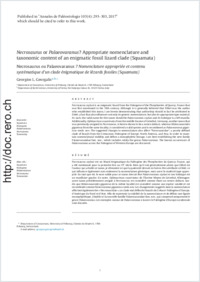Necrosaurus or Palaeovaranus? Appropriate nomenclature and taxonomic content of an enigmatic fossil lizard clade (Squamata)
- Georgalis, Georgios L. Department of Geosciences, University of Fribourg, Switzerland - Department of Earth Sciences, University of Torino, Italy
-
01.10.2017
Published in:
- Annales de Paléontologie. - 2017, vol. 103, no. 4, p. 293–303
English
French
Necrosaurus cayluxi is an enigmatic lizard from the Paleogene of the Phosphorites of Quercy, France that was first mentioned in the 19th century. Although it is generally believed that Filhol was the author who established this taxon, I am herein demonstrating that authorship should in fact be attributed to Zittel, a fact that also influences not only its generic nomenclature, but also its appropriate type material. As such, the valid name for this taxon should be Palaeovaranus cayluxi and its holotype is a left maxilla. Additionally, Ophisauriscus eucarinatus from the middle Eocene of Geiseltal, Germany, another taxon that was previously assigned to Necrosaurus, is herein shown to be a nomen dubium, whereas Melanosauroides giganteus from the same locality, is considered a valid species and is recombined as Palaeovaranus giganteus comb. nov. The suggested changes in nomenclature also affect “Necrosauridae”, a poorly defined clade of lizards from the Cretaceous–Paleogene of Europe, North America, and Asia. In order to maintain nomenclatural stability and define a monophyletic lineage, I am here establishing the new family Palaeovaranidae fam. nov., which includes solely the genus Palaeovaranus. The known occurrences of Palaeovaranus across the Paleogene of Western Europe are discussed.
Necrosaurus cayluxi est un lézard énigmatique du Paléogène des Phosphorites du Quercy, France, qui a été mentionné pour la première fois au 19e siècle. Bien qu’il soit généralement admis que Filhol est l’auteur qui a établi ce taxon, je démontre ici que la paternité devrait en fait en être attribuée à Zittel, ce qui influence également non seulement la nomenclature générique, mais aussi le matériel type approprié. En tant que tel, le nom valide pour ce taxon devrait être Palaeovaranus cayluxi et son holotype est un maxillaire gauche. En outre, Ophisauriscus eucarinatus de l’Éocène Moyen de Geiseltal, Allemagne, autre taxon précédemment assigné à Necrosaurus, est considéré comme étant un nomen dubium, tandis que Melanosauroides giganteus de la même localité est considéré comme une espèce valable et est recombinée comme Palaeovaranus giganteus comb. nov. Les changements suggérés dans la nomenclature affectent également les « Necrosauridae », un clade mal défini de lézards du Crétacé–Paléogène d’Europe, d’Amérique du Nord et d’Asie. Afin de maintenir la stabilité de la nomenclature et de définir une lignée monophylétique, j’établis ici la nouvelle famille Palaeovaranidae fam. nov., qui comprend uniquement le genre Palaeovaranus. Les exemples connus de Palaeovaranus à travers le Paléogène d’Europe occidentale sont discutés.
- Faculty
- Faculté des sciences et de médecine
- Department
- Département de Géosciences
- Language
-
- English
- Classification
- Palaeontology
- License
-
License undefined
- Identifiers
-
- RERO DOC 323921
- DOI 10.1016/j.annpal.2017.10.001
- Persistent URL
- https://folia.unifr.ch/unifr/documents/307256
Statistics
Document views: 101
File downloads:
- pdf: 1302
